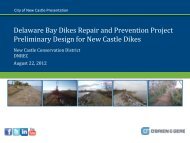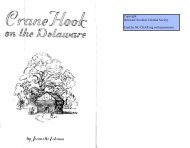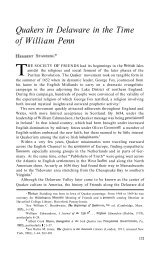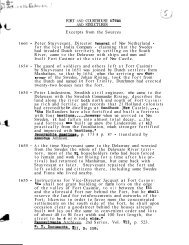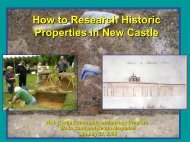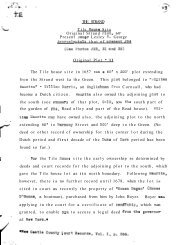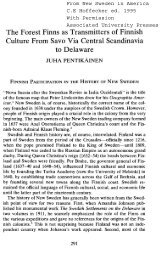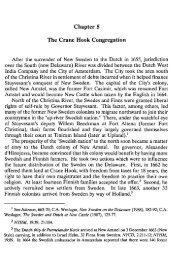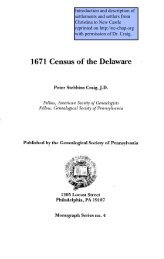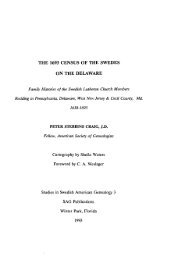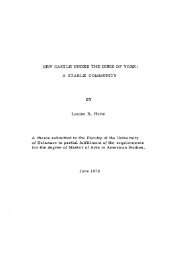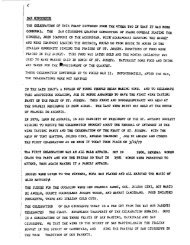Historic Preservation in a Delaware Town - NC CHAP
Historic Preservation in a Delaware Town - NC CHAP
Historic Preservation in a Delaware Town - NC CHAP
Create successful ePaper yourself
Turn your PDF publications into a flip-book with our unique Google optimized e-Paper software.
"The Gospel of New Castle":<br />
<strong>Historic</strong> <strong>Preservation</strong> <strong>in</strong> a<br />
<strong>Delaware</strong> <strong>Town</strong><br />
A<br />
LTHOUGH <strong>Delaware</strong>ans know New Castle as the colonial capital<br />
of their state, and hundreds of schoolchildren visit it annually<br />
when study<strong>in</strong>g state history, out-of-staters must usually<br />
make a deliberate effort to discover the town. It is not a place that<br />
anyone would know from simply pass<strong>in</strong>g through because the roads do<br />
not pass through it; they only pass it by. Over the centuries New Castle<br />
has repeatedly suffered the fate of be<strong>in</strong>g passed by. At various times a<br />
seat of government, manufactur<strong>in</strong>g, and transportation, it has always<br />
been eclipsed by other cities so that today the mayor worries that the<br />
town has-become a "bedroom community9; with no 'economic base of its<br />
own. 1<br />
One bus<strong>in</strong>ess does prosper <strong>in</strong> New Castle, though, and that is tourism.<br />
When the town lost its preem<strong>in</strong>ence <strong>in</strong> transportation and trad<strong>in</strong>g <strong>in</strong> the<br />
first half of the n<strong>in</strong>eteenth century, it fell <strong>in</strong>to an economic slump that<br />
prevented many residents from dramatically chang<strong>in</strong>g their homes, so<br />
that it reta<strong>in</strong>ed the appearance of its Federal-era heyday. Visitors today<br />
stroll down cobblestone streets past antique shops and historic houses, or<br />
wander along the path that follows the river <strong>in</strong> Battery Park, imag<strong>in</strong><strong>in</strong>g<br />
the merchant ships that docked at the wharf <strong>in</strong> days long past. The<br />
town's romantic image is enhanced by the program of historic preservation<br />
that has been followed <strong>in</strong> New Castle for so long and to such an<br />
extent that one early supporter has referred to it as "the gospel of New<br />
castle."*<br />
* Deborah Van Riper Harper received her M.A. <strong>in</strong> history from the University of<br />
<strong>Delaware</strong>. She is employed by the W<strong>in</strong>terthur Museum and lives <strong>in</strong> New Castle.<br />
' "Mayor Kl<strong>in</strong>gmeyer Urges City Update Its Comprehensive Plan," New Castle Eagle,<br />
Apr. 4, 1990.<br />
Worth<strong>in</strong>gton G. Button to Daniel Moore Bates (hereafter DMB), Jan. 16, 1951,<br />
Bates Family Papers, Box 69, <strong>Historic</strong>al Society of <strong>Delaware</strong>, Wilm<strong>in</strong>gton (hereafter re-<br />
ferred to as Bates 69), All Bates papers are at the <strong>Historic</strong>al Society of <strong>Delaware</strong> (hereafter<br />
HSD) unless otherwise noted.
7 8 DELAWARE HISTORY<br />
The orig<strong>in</strong>s of America's historic preservation movement are found<br />
<strong>in</strong> the mid n<strong>in</strong>eteenth century. As the United States gradually rose from<br />
an <strong>in</strong>secure fledgl<strong>in</strong>g nation to a world power, Americans began to take<br />
pride <strong>in</strong> their accomplishments, which resulted <strong>in</strong> a new appreciation for<br />
the people and events that had brought them such success. This <strong>in</strong>-<br />
cluded the veneration of places that had witnessed American triumphs.<br />
Charles B. Hosmer, Jr., has noted that even before the Civil War one<br />
f<strong>in</strong>ds "abundant evidence of an emergent national consciousness that<br />
caused some <strong>in</strong>dividuals to look upon the preservation of historic sites as<br />
a sign of cultural maturity."3<br />
Early activists cited a structure's antiquity and its association with<br />
hallowed persons or events as justification for its preservation. The<br />
strongest rally<strong>in</strong>g cry sounded when a build<strong>in</strong>g bore an association with<br />
George Wash<strong>in</strong>gton. His godlike stature encouraged Ann Pamela Cun-<br />
n<strong>in</strong>gham's successful drive <strong>in</strong> the 1850s to preserve Mount Vernon as a<br />
national shr<strong>in</strong>e. Her effort was the first attempt to establish a national<br />
base of support for historic preservation. Other early campaigns were<br />
not as well organized, and many failed; but the demolition of an impor-<br />
tant structure, such as the John Hancock Mansion <strong>in</strong> Boston, motivated<br />
preservationists to prevent additional losses.<br />
In the late n<strong>in</strong>eteenth and early twentieth centuries, a ris<strong>in</strong>g sense of<br />
national consciousness encouraged widespread enthusiasm for historic<br />
preservation as a vehicle for <strong>in</strong>still<strong>in</strong>g American values <strong>in</strong> the vast num-<br />
bers of immigrants who arrived heie. Many "established" Americans,<br />
whose ancestors had arrived generations earlier, feared that their tradi-<br />
tions would be underm<strong>in</strong>ed by the <strong>in</strong>flux of foreign ideas. Anticipat<strong>in</strong>g<br />
the very destruction of their way of life, they attempted to <strong>in</strong>doctr<strong>in</strong>ate<br />
the newcomers with their own ideals. Part of the process of American-<br />
ization <strong>in</strong>cluded visits to sites so steeped <strong>in</strong> history that the foreigners<br />
would come to value American traditions above their own.4 Eventually,<br />
disillusioned by their experience with global <strong>in</strong>volvement <strong>in</strong> World War<br />
I, Americans became so isolationist <strong>in</strong> their outlook that legislation was<br />
passed <strong>in</strong> 1924 that severely restricted immigration to the United States.<br />
The next decade saw the establishment of many shr<strong>in</strong>es to American<br />
democracy. In 1924 the American W<strong>in</strong>g opened at the Metropolitan<br />
Museum of Art <strong>in</strong> New York City, followed shortly thereafter by Henry<br />
Ford's Greenfield Village <strong>in</strong> Dearborn, Michigan, and John D. Rock-<br />
efeller's Colonial Williamsburg. Those museums sought not only to ed-<br />
ucate immigrants, but also to glorify American achievement for the ed-<br />
ification of all people. Many took advantage of the freedom provided by<br />
Charles B. Hosmer, Jr., Presence of the Past: A History of the Preseruation Movement <strong>in</strong><br />
the United States Before Williamsburg (New York, 1965), p. 22.<br />
William B. Rhoads, "The Colonial Revival and the Americanization of Immi-<br />
grants," <strong>in</strong> The Colonial Reuival <strong>in</strong> America, ed. Alan Axelrod (New York, 1985), p. 341.
higher wages, <strong>in</strong>creased leisure time, and the newly popular automobile<br />
to travel to national parks and historic sites.5<br />
In addition to greater freedom, the mobility provided by <strong>in</strong>expensive<br />
cars also brought problems. People took jobs far away from their hometowns,<br />
which resulted <strong>in</strong> the loss of extended family networks and a<br />
related concern for the breakdown of traditional values. In addition, the<br />
many new highways, fill<strong>in</strong>g stations, park<strong>in</strong>g lots, and repair shops <strong>in</strong>truded<br />
upon bucolic farmlands and forest^.^ <strong>Preservation</strong> was seen not<br />
only as the glorification of American achievement but also as a way to<br />
hold on to a landscape, as well as a way of life, that was chang<strong>in</strong>g much<br />
too fast.<br />
The course of preservation <strong>in</strong> New Castle parallels the national movement.<br />
Its stirr<strong>in</strong>gs are evident even <strong>in</strong> the early 1820s, when John Watson,<br />
pass<strong>in</strong>g through the town, described the humility he felt at the sight<br />
of the ancient Tile House on the strand.' He noted the irons proclaim<strong>in</strong>g<br />
the date "1687" imbedded <strong>in</strong> the front of the structure, a date which<br />
provided the house with an aura of timeworn nobility.<br />
After its demolition <strong>in</strong> 1884, the Tile House assumed legendary status<br />
<strong>in</strong> the m<strong>in</strong>ds of town residents. The build<strong>in</strong>g <strong>in</strong>spired local artists whose<br />
images of the house were more or less fanciful, but consistent <strong>in</strong> the<br />
prom<strong>in</strong>ent display of the date irons. In fact, the date of the build<strong>in</strong>g's<br />
erection is conjectural, and the date irons may not have been orig<strong>in</strong>al to<br />
it. All that has been ascerta<strong>in</strong>ed regard<strong>in</strong>g the date of construction is that<br />
the build<strong>in</strong>g did not exist when John Boyer bought the property <strong>in</strong> 1678,<br />
but after his death around 1704 his daughters' <strong>in</strong>heritance <strong>in</strong>cluded a<br />
substantial brick house on the plot. The irons are not present <strong>in</strong> Benjam<strong>in</strong><br />
Latrobe's depiction of the Tile House on his 1804-05 survey of<br />
New Castle; s<strong>in</strong>ce his view does <strong>in</strong>clude other significant details, it is<br />
unlikely that he simply ignored them. The house was renovated <strong>in</strong> the<br />
early n<strong>in</strong>eteenth century and it is possible that the irons were added<br />
then, but if so, that fact was forgotten by 1884.~ By that time, the 1687<br />
date was considered accurate, and the Tile House came to be viewed as<br />
New Castle's John Hancock Mansion-a terrible loss, one not to be repeated.<br />
One person <strong>in</strong>terested <strong>in</strong> the lost Tile House was local artist Laussat<br />
Richter Rogers. Like others, he pa<strong>in</strong>ted images of the old landmark, but<br />
his <strong>in</strong>fluence <strong>in</strong> New Castle went beyond pa<strong>in</strong>t<strong>in</strong>g. He carried out several<br />
Charles B. Hosmer, <strong>Preservation</strong> Comes of Age: From Williamsburg to the National<br />
Trust, 1926-1949, 2 vols. (Charlottesville, 1981), 1:2.<br />
Ibid.<br />
' ~ ohn Watson, Annals of Philadelphia and Pennsylvania, 1844 edition, 2 vols., 2:539,<br />
cited <strong>in</strong> Thomas Beckman to Roderick Blackburn, Jan. 3, 1986, museum registrar's file,<br />
"Tile House--New Castle 1687 date irons," HSD.<br />
Beckman to Blackburn, Jan. 3, 1986, museum registrar's file, "Tile House-New<br />
Castle 1687 date irons," HSD.
80 DELAWARE HISTORY<br />
FIGURE 1. The Tile House, shortly before its demolition <strong>in</strong> 1884. Compare<br />
this photograph with the idealized view on the cover. (Collections of the Histor-<br />
ical Society of <strong>Delaware</strong>.)<br />
restorations <strong>in</strong> New Castle <strong>in</strong> the early twentieth century, <strong>in</strong>clud<strong>in</strong>g those<br />
of the Amstel House and Immanuel Episcopal ~ hurch.~<br />
The Amstel House, so named by the owners for whom Rogers did his<br />
restoration, was home to such prom<strong>in</strong>ent early <strong>Delaware</strong>ans as Nicholas<br />
Van Dyke, act<strong>in</strong>g president of <strong>Delaware</strong> between 1783 and 1786, and his<br />
son-<strong>in</strong>-law Kensey Johns, who served as state chancellor. Had Van Dyke<br />
and Johns not been famous <strong>in</strong> their own right, their place <strong>in</strong> history,<br />
along with that of the Amstel House, would nevertheless have been<br />
assured by the legend that George Wash<strong>in</strong>gton visited the house for the<br />
wedd<strong>in</strong>g of Johns to Van Dyke's daughter Ann <strong>in</strong> 1784. The house<br />
changed hands several times <strong>in</strong> the decades follow<strong>in</strong>g, ultimately suffer-<br />
<strong>in</strong>g the <strong>in</strong>dignity of hav<strong>in</strong>g its spaces divided up after 1870 for use by<br />
Laussat Richter Rogers (1866-1957) was born <strong>in</strong> California but had close family<br />
ties to New Castle. After complet<strong>in</strong>g tra<strong>in</strong><strong>in</strong>g as an architect <strong>in</strong> the 1890s, he returned to<br />
New Castle to live at Boothhurst, his family home just outside of town. An advocate of the<br />
colonial revival style of architecture, he was <strong>in</strong>volved <strong>in</strong> several preservation projects <strong>in</strong> the<br />
town <strong>in</strong> the early twentieth century. He also founded the N m Amstel Magaz<strong>in</strong>e <strong>in</strong> 1908, by<br />
which he claimed credit for "rescu<strong>in</strong>g from oblivion the name of New Amstel" (Gene E.<br />
Harris, biographical essay <strong>in</strong> Lawat Richter Rogers [Chadds Ford, Pa., 19861, pp. 7-15).
FIGURE 2. Interior of Irnmanuel Church dur<strong>in</strong>g the Victorian era. (Collectionis<br />
of the <strong>Historic</strong>al Society of <strong>Delaware</strong>.)<br />
various tenants. Such destruction, however, was not sufficient to blot the<br />
vision of Wash<strong>in</strong>gton's presence, so when the house was purchased by<br />
Rogers's relatives Sophia and Henry Hanby Hay, they commissioned<br />
him to restore its former splendor. The grandeur to which Rogers re-<br />
stored the house possibly exceeded its orig<strong>in</strong>al stature, for he is believed<br />
to have added architectural elements to create an ideal colonial relic."<br />
Rogers's changes to Immanuel Church were part of a long series of<br />
renovations that began soon after the church was built <strong>in</strong> the early<br />
1700s. It was enlarged several times <strong>in</strong> the eighteenth century, but the<br />
n<strong>in</strong>eteenth century saw the most dramatic changes. In the 1820s William<br />
Strickland, formerly assistant to Benjam<strong>in</strong> Latrobe but by then one of<br />
the lead<strong>in</strong>g architects of the day, added the transepts and tower with its<br />
spire. Thereafter the church's exterior experienced few alterations, but<br />
its <strong>in</strong>terior reflected chang<strong>in</strong>g tastes. In the 1850s, the sanctuary was<br />
Victorianized with the chancel recessed <strong>in</strong>to the tower and a permanent<br />
altar <strong>in</strong>stalled aga<strong>in</strong>st the backdrop of a large sta<strong>in</strong>ed glass w<strong>in</strong>dow, the<br />
whole crowned by an overarch<strong>in</strong>g gilt <strong>in</strong>scription, "The Lord is <strong>in</strong> His<br />
Holy Temple." By the early twentieth century, the backlash aga<strong>in</strong>st the<br />
excesses of Victorian taste demanded the elim<strong>in</strong>ation of those <strong>in</strong>fluences<br />
lo Conversation with Kathy Bratton, director, New Castle <strong>Historic</strong>al Society, May<br />
21, 1990.
82 DELAWARE HISTORY<br />
FIGURE 3. Interior of Irnrnanuel Church, 19.56, show<strong>in</strong>g Laussat Rogers's<br />
colonial revival alterations. (Collections of the <strong>Historic</strong>al Society of <strong>Delaware</strong>.)<br />
from a half century earlier. Rogers, a member of the church, was en-<br />
listed to make the changes.<br />
In the early 1900s Rogers began "correct<strong>in</strong>g" the Victorian Immanuel<br />
by <strong>in</strong>troduc<strong>in</strong>g architectural details <strong>in</strong> the colonial revival style. He de-<br />
signed a new pulpit, altar, and lectern, and <strong>in</strong> 1918 he replaced the<br />
sta<strong>in</strong>ed glass w<strong>in</strong>dow." The Wilm<strong>in</strong>gton Every Even<strong>in</strong>g, greet<strong>in</strong>g his ef-<br />
forts with accolades, described the earlier w<strong>in</strong>dow as "a monstrosity" and<br />
Rogers's improvements as "rightly named, and not the k<strong>in</strong>d that will<br />
make the heads of future generations hanf <strong>in</strong> shame, because their<br />
forebearers had bad taste <strong>in</strong>stead of good."1<br />
Rogers also played a part <strong>in</strong> the restoration of the George Read I1<br />
" Christopher M. Agnew, "A Brief Architectural History of Immanuel Church" <strong>in</strong><br />
God With Us: a Cont<strong>in</strong>u<strong>in</strong>g Presence and the Vital Records Taken from the Parish Registers of<br />
Immanuel Church, N m Castle, <strong>Delaware</strong>, ed. Christopher M . Agnew (New Castle, Del., 1986),<br />
p. 2.<br />
Wilm<strong>in</strong>gton Eve? Even<strong>in</strong>g, Nov. 23, 1918, cited <strong>in</strong> Agnew, p. 2.
NEW CASTLE 83<br />
House <strong>in</strong> the 1920s for its new owners, Philip and Lydia Laird. Both of<br />
the Lairds came from prom<strong>in</strong>ent Maryland families, but they met and<br />
married <strong>in</strong> Wilm<strong>in</strong>gton, where Philip was a partner <strong>in</strong> his brother's firm,<br />
Laird and Co. They acquired the Read House <strong>in</strong> 1920, and <strong>in</strong> 1925<br />
Rogers was asked to create a rustic taproom <strong>in</strong> the basement of the<br />
house. A casual counterpart to the formal rooms upstairs, the space<br />
epitomized how freely early collectors brought together a hodgepodge<br />
of old artifacts to create an ideal colonial fantasy.13<br />
Already a well-known property before the Lairds came to New Castle,<br />
the Read House fostered a sense of pride among townspeople. Built<br />
between 1797 and 1804 by George Read 11, son of a signer of the<br />
Declaration of Independence and the United States Constitution, it was<br />
considered pretentious when new, but by the early twentieth century its<br />
grandeur and patriotic associations endeared it to town residents. When<br />
the Lairds first saw the house <strong>in</strong> 1920 it was for sale, to the dismay of the<br />
local people. An editorial <strong>in</strong> the Wilm<strong>in</strong>gton Every Even<strong>in</strong>g voiced the<br />
concerns of all those who knew the house:<br />
It would be a grave crime to let the old house come <strong>in</strong>to<br />
<strong>in</strong>appreciative ownership and to th<strong>in</strong>k of its be<strong>in</strong>g gutted<br />
of its treasures makes one shudder. . . [the] Every Even<strong>in</strong>g<br />
feels, with most every citizen of the state, that the old house<br />
on the New Castle Strand should be under some sort of<br />
public control or ownership so that it would never be de-<br />
molished nor dismantled.14<br />
The Lairds' purchase of the Read House provided the means of<br />
achiev<strong>in</strong>g the editorialist's goal. They immediately set about restor<strong>in</strong>g<br />
the house, although their "restoration" <strong>in</strong>corporated many changes to<br />
the build<strong>in</strong>g. They did not attempt to determ<strong>in</strong>e exactly how the struc-<br />
ture had looked <strong>in</strong> George Read's day, nor to recreate his taste, but<br />
neither did they violate his <strong>in</strong>tent. In fact, they did exactly what George<br />
Read had done one hundred years previously: they used their home to<br />
illustrate the epitome of fashion and good taste accord<strong>in</strong>g to prevail<strong>in</strong>g<br />
standards. Ultimately, through the Lairds' generosity, the Read House<br />
did become a museum open to the public, but that was decades <strong>in</strong> the<br />
future, and after the Lairds' <strong>in</strong>fluence on preservation <strong>in</strong> New Castle<br />
had moved beyond the sidewalks of the strand.15<br />
l3 Timothy J. Mull<strong>in</strong>, "In the Spirit of the Orig<strong>in</strong>al: Fantasiz<strong>in</strong>g about the 18th<br />
Century with Phillip [sic] and Lydia Laird," <strong>in</strong>terpretive essay, Mar. 1987 (hereafter cited<br />
as Mull<strong>in</strong>), p. 9, George Read 11 House, HSD.<br />
l4 Wilm<strong>in</strong>gton Eve? Even<strong>in</strong>g, Jun. 23, 1920, cited <strong>in</strong> Mull<strong>in</strong>.<br />
l5 Lydia Laird gave the Read House to the <strong>Historic</strong>al Society of <strong>Delaware</strong> <strong>in</strong> 1975.<br />
S<strong>in</strong>ce then it has undergone a thorough restoration to its early-n<strong>in</strong>eteenth-century ap-<br />
pearance, even to the restoration of the orig<strong>in</strong>al brilliant pa<strong>in</strong>t colors, but the d<strong>in</strong><strong>in</strong>g room,
DELAWARE HISTORY<br />
The Read House first opened <strong>in</strong>formally to the public <strong>in</strong> May 1924 as<br />
a featured attraction <strong>in</strong> the first "Day <strong>in</strong> Old New Castle." Still held every<br />
year, "A Day <strong>in</strong> Old New Castle" was organized by Anne Rodney Jan-<br />
vier, a descendant of George Read, as a fund-raiser for Immanuel<br />
Church. The first organized promotion of New Castle's historic trea-<br />
sures, the day provided a chance for the public to visit the old houses<br />
and sip tea served by hostesses <strong>in</strong> period costume. "If you're especially<br />
lucky," one writer tempted, "you may f<strong>in</strong>d yourself dr<strong>in</strong>k<strong>in</strong>g a julep <strong>in</strong> a<br />
garden under lavender-blossomed paulownia trees."16 Beyond this, the<br />
day also supplied New Castle's response to the Met's American W<strong>in</strong>g and<br />
the Immigration Act of 1924. Already possess<strong>in</strong>g a substantial immi-<br />
grant population <strong>in</strong> its West End, the town now had a way to <strong>in</strong>still<br />
proper American values <strong>in</strong>to the foreigners resid<strong>in</strong>g so close to the co-<br />
lonial stronghold. The churches, the Court House, and the Old <strong>Town</strong><br />
Hall rem<strong>in</strong>ded the public of the moral wisdom upon which the nation<br />
was founded, while the stately houses conveyed the quiet strength of<br />
home and hearth.<br />
The Lairds' participation <strong>in</strong> "A Day <strong>in</strong> Old New Castle" led to their<br />
<strong>in</strong>volvement <strong>in</strong> other preservation efforts <strong>in</strong> the town. In March 1929<br />
the Amstel House, hav<strong>in</strong>g changed hands after the Hanbys' restoration,<br />
was to be sold. Concerned that it would be altered or demolished, Philip<br />
Laird and other prom<strong>in</strong>ent townsfolk advocated the formation of a cor-<br />
poration to purchase the property. Tout<strong>in</strong>g the names of Nicholas Van<br />
Dyke, Kensey Johns, and George Wash<strong>in</strong>gton, the group sought funds<br />
to preserve the house as a "model home of the Colonial period."17 By<br />
December 1931, with the property purchased and free of debt, Laird,<br />
Richard S. Rodney, C. Douglass Buck, and Francis Janvier sought to<br />
establish a non-stock corporation to provide for the care of the build-<br />
<strong>in</strong>g.I8 They advocated a self-perpetuat<strong>in</strong>g board of trustees, to ensure<br />
that "the build<strong>in</strong>g would always be <strong>in</strong> charge of those most <strong>in</strong>terested <strong>in</strong><br />
its preservation and welfare." They also recommended purchas<strong>in</strong>g the<br />
adjo<strong>in</strong><strong>in</strong>g lot, orig<strong>in</strong>ally part of the Amstel House property, <strong>in</strong> order to<br />
remove a build<strong>in</strong>g that they perceived to be a fire hazard. At a meet<strong>in</strong>g<br />
held on December 19, the attendees voted to <strong>in</strong>corporate the New Castle<br />
basement taproom, and one bedroom have been left as decorated by Lydia Laird <strong>in</strong><br />
recognition of her generosity.<br />
'%nthony Higg<strong>in</strong>s, New Castle, <strong>Delaware</strong>, 1651-1939 (Boston, 1939), p. 4.<br />
l7 Open letter from Mary E. Shaw, Harriett M. Cavenaugh, Annie R. Janvier, C.<br />
Douglass Buck, Philip Laird, Richard S. Rodney, Mar. 5, 1929, files of the New Castle<br />
<strong>Historic</strong>al Society (hereafter referred to as <strong>NC</strong>HS).<br />
l8 From a New Castle family of long stand<strong>in</strong>g, Judge Richard S. Rodney (1882-<br />
1963) lived on Third Street and was <strong>in</strong>tensely <strong>in</strong>terested <strong>in</strong> anyth<strong>in</strong>g relat<strong>in</strong>g to New Castle<br />
history. Elected president of the New Castle <strong>Historic</strong>al Society <strong>in</strong> 1934, he held the position<br />
until his death <strong>in</strong> 1963. Francis Janvier (1874-1940) came from another old New Castle<br />
family. C. Douglass Buck (189C1965) served as governor of <strong>Delaware</strong> from 1929 to 1937.
NEW CASTLE 85<br />
FIGURE 4. The Amstel House, 1919. (Collections of the <strong>Historic</strong>al Society of<br />
<strong>Delaware</strong>.)<br />
Society for the <strong>Preservation</strong> of Antiquities, which would be re<strong>in</strong>corpo-<br />
rated <strong>in</strong> 1934 as the New Castle <strong>Historic</strong>al Society. Among those elected<br />
to the board of directors was Philip ~aird.'~<br />
While the New Castle <strong>Historic</strong>al Society pursued its mission to pre-<br />
serve the Amstel House, another group organized with the <strong>in</strong>tent of<br />
preserv<strong>in</strong>g all of New Castle. The <strong>Delaware</strong> Society for the <strong>Preservation</strong><br />
of Antiquities was founded <strong>in</strong> January 1937 with Mary Wilson Thomp-<br />
son as president. Prior to accept<strong>in</strong>g her office, Thompson urged the<br />
leadership role upon another of the society's members, Col. Daniel<br />
Moore Bates. He decl<strong>in</strong>ed the offer, claim<strong>in</strong>g to be too busy <strong>in</strong> other<br />
enterprises to give the position the attention it deserved. He assured her,<br />
though, of his deep <strong>in</strong>terest <strong>in</strong> the society, stat<strong>in</strong>g that <strong>Delaware</strong> pro-<br />
vided a wonderful opportunity for such an endeavor, especially <strong>in</strong> the<br />
old town of New<br />
Bates was a native <strong>Delaware</strong>an, born <strong>in</strong> Wilm<strong>in</strong>gton <strong>in</strong> the year of the<br />
nation's centennial, 1876. Educated <strong>in</strong> private schools <strong>in</strong> Wilm<strong>in</strong>gton<br />
I9 Letter from C. Douglass Buck, Philip Laird, Francis deH. Janvier, and Richard S.<br />
Rodney addressed "To the Patrons of Amstel House," Dec. 4, 1931, <strong>NC</strong>HS files; m<strong>in</strong>utes<br />
of the board of directors, Dec. 19, 1931, m<strong>in</strong>ute book, <strong>NC</strong>HS; and certificate of <strong>in</strong>corpo-<br />
ration, Jun. 1934, <strong>NC</strong>HS files.<br />
20 DMB to Mary Wilson Thompson, Dec. 31, 1936, Bates 69, <strong>Delaware</strong> Society for<br />
the <strong>Preservation</strong> of Antiquities (hereafter referred to as DSPA) file.<br />
I_ -
86 DELAWARE HISTORY<br />
and Philadelphia and a graduate of the Massachusetts Institute of Tech-<br />
nology, he began his career <strong>in</strong> the textile <strong>in</strong>dustry with Joseph Bancroft<br />
& Sons Co. <strong>in</strong> Wilm<strong>in</strong>gton. He spent his work<strong>in</strong>g years with several<br />
textile and eng<strong>in</strong>eer<strong>in</strong>g firms and developed a strong <strong>in</strong>terest <strong>in</strong> scien-<br />
tific management. Dur<strong>in</strong>g World War I, he served as a major and col-<br />
onel <strong>in</strong> the ordnance department of the United States Army. In World<br />
War 11, he spent two and one-half years teach<strong>in</strong>g mathematics to ser-<br />
vicemen at the University of <strong>Delaware</strong>. Bates did not own property <strong>in</strong><br />
New Castle, but lived northwest of Wilm<strong>in</strong>gton <strong>in</strong> Centreville where his<br />
neighbors <strong>in</strong>cluded Henry Francis du Pont and Louise du Pont Crown-<br />
<strong>in</strong>shield, both of whom demonstrated great <strong>in</strong>terest <strong>in</strong> preserv<strong>in</strong>g relics<br />
of the American past, and both of whom Bates counted as friends. It<br />
may have been their <strong>in</strong>fluence that encouraged him to pursue the pos-<br />
sibilities of preservation <strong>in</strong> New Castle, which he viewed <strong>in</strong>itially as an<br />
outlet for his creative energies as he retired from active bus<strong>in</strong>ess. So<br />
although he referred to New Castle casually as an area where the new<br />
<strong>Delaware</strong> Society for the <strong>Preservation</strong> of Antiquities might f<strong>in</strong>d oppor-<br />
tunity, his <strong>in</strong>terest <strong>in</strong> the town was hardly casual.21<br />
Bates's <strong>in</strong>terest <strong>in</strong> New Castle extended at least as far back as 1933,<br />
when, as a member of the Society of Colonial Wars <strong>in</strong> the State of<br />
<strong>Delaware</strong>, he received a communique from Electus D. Litchfield of the<br />
Society <strong>in</strong> the State of New York regard<strong>in</strong>g the future of New Castle.<br />
The Society of Colonial Wars, an hereditary fraternity organized <strong>in</strong> 1892<br />
to honor the memory of colonials who served <strong>in</strong> the military, <strong>in</strong>cluded as<br />
part of its mission the preservation of historic sites. Litchfield had visited<br />
New Castle and believed the town could benefit from the society's <strong>in</strong>-<br />
fluence. He encouraged Bates to work to have New Castle declared an<br />
historic monument and placed under the care of the Society of Colonial<br />
Wars <strong>in</strong> the State of <strong>Delaware</strong>. He also suggested that while the state of<br />
<strong>Delaware</strong> itself need not purchase any property <strong>in</strong> the town, an arrange-<br />
ment might be worked out whereby property owners would ma<strong>in</strong>ta<strong>in</strong><br />
their homes <strong>in</strong> orig<strong>in</strong>al condition and occasionally open them to the<br />
public <strong>in</strong> exchange for exemption from taxation.22<br />
Bates took Litchfield's suggestions seriously and decided to pursue<br />
the possibility of see<strong>in</strong>g New Castle restored <strong>in</strong> the same manner as<br />
Williamsburg. In 1934 he wrote to the Reverend W. A. R. Goodw<strong>in</strong>, the<br />
Virg<strong>in</strong>ia clergyman who had captured Rockefeller's <strong>in</strong>terest for<br />
Williamsburg, to <strong>in</strong>form him of the possibilities of New Castle. Goodw<strong>in</strong><br />
wrote back at length. Already personally familiar with New Castle, he<br />
shared Bates's enthusiasm for its potential, but raised an issue that was<br />
'' DMB to Andrew H. Hepburn, Apr. 10, 1946, Bates 69, Hepburn & Perry, Shaw,<br />
and Hepburn from Nov. 1, 1946 file.<br />
'' DMB to Electus D. Litchfield, Jun. 1933, Bates 69, DSPA file.
NEW CASTLE 8 7<br />
FIGURE 5. Daniel Moore Bates. (Collections of the <strong>Historic</strong>al Society of <strong>Delaware</strong>.)<br />
to plague all of Bates's efforts: New Castle had no Rockefeller. The<br />
problems that Bates faced were different from those encountered <strong>in</strong><br />
Williamsburg, where f<strong>in</strong>ancial needs were supplied by one <strong>in</strong>dividual<br />
and the <strong>in</strong>volvement of state and local agencies was limited. Goodw<strong>in</strong><br />
stressed the need for concerted action and a strong national program for<br />
preservation to assist <strong>in</strong>dividuals and community groups, someth<strong>in</strong>g not<br />
yet available to assist the New Castle eff~rt.'~<br />
Bates hoped that the newly formed <strong>Delaware</strong> Society for the Preser-<br />
vation of Antiquities would provide a pool of resources to help him<br />
fulfill his goal. He was, however, cautious <strong>in</strong> his approach, recogniz<strong>in</strong>g<br />
that potential supporters might be scared off by the difficulties they<br />
would come up aga<strong>in</strong>st. One of the early meet<strong>in</strong>gs of the society, <strong>in</strong> the<br />
spr<strong>in</strong>g of 1937, featured Litchfield and Goodw<strong>in</strong> as speakers, their pres-<br />
ence arranged by Bates. For the same meet<strong>in</strong>g, he also <strong>in</strong>vited his old<br />
friend and schoolmate Andrew Hepburn to make a presentation. Hep-<br />
burn was a partner <strong>in</strong> the Boston architectural firm of Perry, Shaw, and<br />
Hepburn, which had carried out the restoration of Colonial Williams-<br />
burg. Bates was candid <strong>in</strong> his <strong>in</strong>vitation to Hepburn to speak at the<br />
society's May gather<strong>in</strong>g:<br />
The meet<strong>in</strong>g Friday we want to devote to the subject of the<br />
work done at Williamsburg, . . . without lay<strong>in</strong>g too much<br />
stress upon New Castle. . . . There are some people among<br />
23 W. A. R. Goodw<strong>in</strong> to DMB, Mar. 23, 1934, Bates 69, DSPA file.
the older residents there who are very shy about commit-<br />
t<strong>in</strong>g themselves <strong>in</strong> any way to any sort of outside regula-<br />
tion, or zon<strong>in</strong>g restrictions, etc., and we do not want to try<br />
to shape up any New Castle program until <strong>in</strong>terest gener-<br />
ally <strong>in</strong> these matters has been aroused, and until the pos-<br />
sible leaders <strong>in</strong> <strong>Delaware</strong> <strong>in</strong> such a movement can have the<br />
benefit of consultation and advice from yourself and Dr.<br />
Goodw<strong>in</strong> and Mr. itchf field.'^<br />
After the May meet<strong>in</strong>g, Electus Litchfield wrote to Mary Thompson<br />
recommend<strong>in</strong>g the immediate organization of a foundation that would<br />
strive to preserve New Castle <strong>in</strong> perpetuity. The first priority of this<br />
foundation would be to sponsor a survey of the town to determ<strong>in</strong>e which<br />
of the build<strong>in</strong>gs should be designated historic monuments. Among those<br />
he recommended for a seat on the committee were Philip Laird and<br />
Daniel Moore ~ates.'"<br />
The <strong>Delaware</strong> Society for the <strong>Preservation</strong> of Antiquities prepared to<br />
take on that role of preserv<strong>in</strong>g New Castle through its efforts to preserve<br />
the so-called Old Dutch House on Third Street. Bates wrote to W. A. R.<br />
Goodw<strong>in</strong> <strong>in</strong> July 1937 that the society stood a good chance of obta<strong>in</strong><strong>in</strong>g<br />
at least the control of, and possibly the title to, that ancient build<strong>in</strong>g; by<br />
December, the society owned the house. Five members of the society-<br />
H. Rodney Sharp, Alfred Bissell, Mrs. William C. Spruance, Mrs. Mac-<br />
millan Hoopes, and Bates-underwrote the purchase cost of $2,500. In<br />
a letter sent to members of the f<strong>in</strong>ance committee announc<strong>in</strong>g the pur-<br />
chase of the house, committee chairman Bates reported that an'addi-<br />
tional $7,500 would be needed to renew the build<strong>in</strong>g's understructure<br />
and foundation, which had suffered from termites. Beyond the money<br />
required to restore the build<strong>in</strong>g's structural <strong>in</strong>tegrity, still more would<br />
have to be raised to furnish the house. Bates concluded his letter by<br />
stat<strong>in</strong>g that the f<strong>in</strong>ancial support of the entire society and of all Dela-<br />
wareans would be needed to preserve the Dutch ~ouse.'~<br />
The society and the public responded enthusiastically. In January<br />
1938, the underwriters' money was refunded because the purchase price<br />
had been raised from contributions. Restoration went on through 1938.<br />
Furnished with period artifacts, most provided by society member Lou-<br />
ise du Pont Crown<strong>in</strong>shield, the restored house was <strong>in</strong>cluded <strong>in</strong> New<br />
Castle, <strong>Delaware</strong>: 1651-1939, a book published by the society that fea-<br />
tured photographs of New Castle landmarks. By 1940, $7,500 had been<br />
24 DMB to Andrew H. Hepburn, May 5, 1937, Bates 69, DSPA file.<br />
'5 Electus D. Litchfield to Mary Wilson Thompson, Jun. 1937, Bates 69, DSPA file.<br />
2G DMB to Alfred E. Bissell, Dec. 12, 1937, Bates 69, Laird file; and DMB to<br />
W. A. R. Goodw<strong>in</strong> Jul. 13, 1937, and DMB to Mrs. H. R. Thompson, Philip Laird, Alfred<br />
E. Bissell, Mrs. Francis deH. Janvier, and H. Rodney Sharp, Dec. 27, 1937, Bates 69, DSPA<br />
file.
90 DELAWARE HISTORY<br />
foundation to sponsor a survey of the town and identify sites worthy of<br />
preservation. And he remembered Litchfield's recommendation that<br />
Phili Laird be <strong>in</strong>cluded on the committee to organize that founda-<br />
tion. P8<br />
Philip Laird had a keen <strong>in</strong>terest <strong>in</strong> the formation of such a founda-<br />
tion. He wanted to assure the preservation of the Read House by giv<strong>in</strong>g<br />
the property to such an organization, subject to the Lairds' retention of<br />
life <strong>in</strong>terest. Toward that end he began correspond<strong>in</strong>g with Bates's<br />
friend Andrew Hepburn regard<strong>in</strong>g a systematic preservation of New<br />
Castle. Hepburn <strong>in</strong> turn arranged for Kenneth Chorley, president of<br />
Colonial Williamsburg, to come to New Castle to meet with Laird and<br />
Bates. Chorley, enthusiastic about New Castle's possibilities, reiterated<br />
Litchfield's suggestion that a comprehensive survey must be the first<br />
order of bus<strong>in</strong>ess. To capture the imag<strong>in</strong>ation of a potential benefactor,<br />
skillfully rendered sketches of a fully restored town would say what<br />
words could not. The existence of Colonial Williamsburg proved this,<br />
for it was just such a portfolio that secured Rockefeller's back<strong>in</strong>g for that<br />
project.29<br />
Chorley's reference to Rockefeller echoed Goodw<strong>in</strong>'s earlier caution,<br />
but others pondered the question of sponsorship as well. In 1938, an<br />
anonymous letter <strong>in</strong> the Sunday Star spoke of the need for a benefactor<br />
to renovate and preserve New Castle's wharf area, claim<strong>in</strong>g that the<br />
town could vie with Williamsburg if a sponsor could be found to f<strong>in</strong>ance<br />
the Yet some residents were not <strong>in</strong>cl<strong>in</strong>ed to have New Castle<br />
systematically restored. Many families had roots <strong>in</strong> the town that reached<br />
back generations and were proud of the town just as it was. Perhaps<br />
some resented the <strong>in</strong>terference of a newcomer like Laird, or the med-<br />
dlesomeness of an outsider like Bates. Possibly they questioned the<br />
men's motivation. Laird owned several choice properties <strong>in</strong> New Castle.<br />
Then <strong>in</strong> 1939, through his newly organized New Castle Improvements<br />
Corporation, he purchased the Jefferson House on the Strand to reno-<br />
vate as a colonial <strong>in</strong>n and restaurant. He <strong>in</strong>formed potential <strong>in</strong>vestors<br />
that Battery Park, recently acquired by the city, would be cleaned up <strong>in</strong><br />
the near future, and that all build<strong>in</strong>gs <strong>in</strong> the park and on the wharf<br />
adjo<strong>in</strong><strong>in</strong>g the Jefferson House property should be removed as well,<br />
allow<strong>in</strong>g hotel guests a f<strong>in</strong>e view of the river. Laird's membership on the<br />
Battery Park Commission put him <strong>in</strong> an <strong>in</strong>fluential position, and as the<br />
proprietor of a colonial <strong>in</strong>n <strong>in</strong> the heart of a restored New Castle, he<br />
stood to profit handsomely.31 Bates reported to Hepburn that "some of<br />
Electus D. Litchfield to Mary Wilson Thompson, Jun. 1937, Bates 69, DSPA file.<br />
29 DMB to Kenneth Chorley, Nov. 15, 1948, Bates 69, Laird file; and Hosmer,<br />
<strong>Preservation</strong> Comes of Age, 1 :69.<br />
Wilm<strong>in</strong>gton Sunday Star, May 29, 1938, clipp<strong>in</strong>g <strong>in</strong> Bates 68.<br />
Philip D. Laird to DMB, Oct. 26, 1939, Bates 69, Laird file. Laird stated that
NEW CASTLE 9 1<br />
FIGURE 7. Philip Laird's proposed development of the Jefferson House at<br />
The Strand and <strong>Delaware</strong> Street <strong>in</strong>to a colonial <strong>in</strong>n. (Collections of the <strong>Historic</strong>al<br />
Society of <strong>Delaware</strong>.)<br />
the New Castle people are not very enthusiastic about Mr. Laird's<br />
plans."32<br />
One part of the plan about which Laird was not enthusiastic was the<br />
cost for the prelim<strong>in</strong>ary.draw<strong>in</strong>gs. Andrew Hepburn told the New Castle<br />
group that a set of presentation sketches could be prepared for about<br />
$15,000. Chorley expla<strong>in</strong>ed that this outlay would be an <strong>in</strong>vestment<br />
aga<strong>in</strong>st future gate receipts, which while not on the scale of Williams-<br />
burg's, could be sizeable.33 All agreed that the sketches were essential,<br />
but as they debated the feasibility of obta<strong>in</strong><strong>in</strong>g the necessary funds,<br />
World War I1 began, putt<strong>in</strong>g the project on hold.<br />
After the war, the prospects for New Castle changed somewhat.<br />
Perry, Shaw, and Hepburn, now well known for their work at Williams-<br />
burg and other sites, <strong>in</strong>creased their fee for the comprehensive survey to<br />
$20,000. At the same time, the project took on an air of greater urgency<br />
as spread<strong>in</strong>g <strong>in</strong>dustrial development encroached upon New<br />
F<strong>in</strong>ally, Philip Laird's <strong>in</strong>volvement <strong>in</strong> the project dim<strong>in</strong>ished due to ill-<br />
ness. It fell to Daniel Moore Bates to carry the plan forward.<br />
Bates realized that the chances of success were limited if they de-<br />
pended solely upon his resources. He turned for assistance to his friend<br />
Louise du Pont Crown<strong>in</strong>shield, already known <strong>in</strong> New Castle for her<br />
efforts to preserve the Dutch House on Third Street for the <strong>Delaware</strong><br />
consider<strong>in</strong>g the historic <strong>in</strong>terest <strong>in</strong> New Castle, it was necessary that there be an attractive<br />
<strong>in</strong>n for people to visit, and for this purpose he formed the New Castle Improvements<br />
Corporation. The new firm was a completely separate entity with no ties to Laird and Co.<br />
32 DMB to Andrew H. Hepburn, Oct. 1, 1940, cited <strong>in</strong> Mull<strong>in</strong>, p. 12.<br />
3%osmer, Preremation Comes of Age, 1 :69.<br />
34 Andrew H. Hepburn, "New Castle," <strong>in</strong>troductory essay to the Prelim<strong>in</strong>ary Survey<br />
by Perry, Shaw, and Hepburn, Architects, Dec. 22, 1947, HSD.
92 DELAWARE HISTORY<br />
Society for the <strong>Preservation</strong> of Antiquities. He <strong>in</strong>formed her <strong>in</strong> September<br />
1946 that Perry, Shaw, and Hepburn were prepared to do a prelim<strong>in</strong>ary<br />
survey and additional research work if the $20,000 they required<br />
could be raised. "I am so much <strong>in</strong>terested <strong>in</strong> the New Castle<br />
project," he cont<strong>in</strong>ued, "that with your back<strong>in</strong>g of experience and <strong>in</strong>terest<br />
and such f<strong>in</strong>ancial help as you may be able to give, I am prepared<br />
to ~nderwrite."~~ She responded that she thought it a marvelous project<br />
and one she hoped would be successful, but that her own <strong>in</strong>vestment<br />
would be small because of her <strong>in</strong>volvement with other charitable endeavo<br />
r ~ In . spite ~ ~ of that cautious response, Bates immediately l<strong>in</strong>ked Mrs.<br />
Crown<strong>in</strong>shield's name to his own as cosponsor of the New Castle project.<br />
Bates wasted no time <strong>in</strong> send<strong>in</strong>g out a confidential letter <strong>in</strong>form<strong>in</strong>g<br />
some few "representative residents" of New'Castle that an opportunity<br />
was forthcom<strong>in</strong>g at which a small group of <strong>in</strong>terested persons could<br />
meet with Andrew Hepburn and Kenneth Chorley to discuss options.<br />
Those <strong>in</strong>vited to the meet<strong>in</strong>g, held at the Amstel House, had already<br />
demonstrated an <strong>in</strong>terest <strong>in</strong> preservation through leadership <strong>in</strong> the New<br />
Castle <strong>Historic</strong>al Society and the <strong>Delaware</strong> Society for the <strong>Preservation</strong><br />
of Antiquities. The letter began Bates's selective <strong>in</strong>volvement of <strong>in</strong>fluential<br />
people <strong>in</strong> his plans, a practice that he followed meticulously and<br />
that rewarded his effort^.^' Bates reported to Mrs. Crown<strong>in</strong>shield that<br />
the meet<strong>in</strong>g was a success. He wrote glow<strong>in</strong>gly of the <strong>in</strong>spir<strong>in</strong>g presentation<br />
given by Kenneth Chorley, who appealed to the company's sense<br />
of noblesse oblige <strong>in</strong> urg<strong>in</strong>g them to preserve their town for the benefit<br />
of generations to come.38 To Andrew Hepburn, he wrote of his astonishment<br />
"at the enthusiastic reception of the idea by the people represent<strong>in</strong>g<br />
New Castle who were at the meet<strong>in</strong>g."39 Believ<strong>in</strong>g he now possessed<br />
the <strong>in</strong>terest necessary to carry out his plan (and hop<strong>in</strong>g that the<br />
f<strong>in</strong>ancial back<strong>in</strong>g would follow), Bates, with Chorley act<strong>in</strong>g as advisor,<br />
made a contract with-Perry, Shaw, and Hepburn to beg<strong>in</strong> their survey.<br />
Bates labored unceas<strong>in</strong>gly for the next two and one half years to br<strong>in</strong>g<br />
the survey to the po<strong>in</strong>t at which it could be presented to the public. The<br />
85 DMB to Louise du Pont Crown<strong>in</strong>shield, Sep. 3, 1946, Bates 68, New Castle-<br />
Crown<strong>in</strong>shield correspondence file.<br />
36 Louise du Pont Crown<strong>in</strong>shield to DMB, Sep. 13, 1946. Bates 68, New Castle-<br />
Crown<strong>in</strong>shield correspondence file.<br />
37 DMB and Louise du Pont Crown<strong>in</strong>shield to potential sponsors, Oct. 3, 1946,<br />
Bates 68, New Castle <strong>Historic</strong>al Society file. The potential sponsors <strong>in</strong>cluded Mr. and Mrs.<br />
Newl<strong>in</strong> Booth, Mr. and Mrs. J. Danforth Bush, Jr., Mr. John J. B. Cooper, Miss Mary<br />
Cooper, Mr. and Mrs. Horace Deakyne, Mr. and Mrs. James T. Eliason, Jr., Mr. and Mrs.<br />
J. Rogers Holcomb, Mr. and Mrs. Thomas Holcomb 3rd, Mr. Albert Kruse, Miss Gertrude<br />
Kruse, Mr. and Mrs. Philip D. Laird, and Mr. and Mrs. Richard S. Rodney.<br />
38 DMB to Louise du Pont Crown<strong>in</strong>shield, Oct. 29, 1946. Bates 68, New Castle<br />
<strong>Historic</strong>al Society file.<br />
39 DMB to Andrew H. Hepburn, Oct. 28, 1946, Bates 68, Correspondence-<br />
Hepburn file.
NEW CASTLE 93<br />
work progressed under the umbrella of <strong>Historic</strong> Research, Inc., a non-<br />
profit corporation that Bates established so that contributions to the<br />
preservation effort would be deductible from the <strong>in</strong>come taxes of the<br />
donors. Nevertheless, the greatest stumbl<strong>in</strong>g block proved to be obta<strong>in</strong>-<br />
<strong>in</strong>g f<strong>in</strong>ancial back<strong>in</strong>g. Anxious to make the report public <strong>in</strong> hopes that<br />
more money would thus be forthcom<strong>in</strong>g, Bates chafed at hav<strong>in</strong>g to keep<br />
the work secret to keep real estate speculators from mov<strong>in</strong>g <strong>in</strong>. A letter<br />
sent out to potential benefactors, <strong>in</strong>clud<strong>in</strong>g several du Ponts, proved<br />
unsuccessful. Responses such as H. F. du Pont's were typical: he wrote<br />
that while <strong>in</strong>terested and happy to give some time to the project, his<br />
f<strong>in</strong>ancial contribution would necessarily be small because his funds were<br />
committed elsewhere. Others, while <strong>in</strong>terested, did not wish to be pub-<br />
licly associated with the project. Lammot du Pont Copeland contributed<br />
to the effort, but when Bates wanted to list him as an underwriter, he<br />
refused, stat<strong>in</strong>g that merely show<strong>in</strong>g <strong>in</strong>terest did not make him a spon-<br />
sor. The greatest s<strong>in</strong>gle contribution that Bates received was not mon-<br />
etary, but rather the generosity of Louise Crown<strong>in</strong>shield <strong>in</strong> allow<strong>in</strong>g her<br />
name to be associated with the project. She realized that Bates needed a<br />
name attached to his endeavor that would draw others to the band-<br />
wagon, if only <strong>in</strong> the <strong>in</strong>terest of vicarious association. Unfortunately,<br />
prestige alone did not pay the architects. In the end, Bates contributed<br />
over $15,000 to the cost of the survey. He wrote to a friend, "Sometimes<br />
this New Castle work . . . has made me feel like a traveler along a lonely<br />
road."40<br />
In addition to pay<strong>in</strong>g for the bulk of Perry, Shaw, and Hepburn's<br />
work through his firm <strong>Historic</strong> Research, Inc., Bates found himself con-<br />
tribut<strong>in</strong>g to other associated activities, hop<strong>in</strong>g to see some return from<br />
his efforts. He arranged for some New Castle merchants and council-<br />
men to go to Williamsburg to see the commercial prosperity that re-<br />
sulted from the restoration there. He also paid at least part of the cost<br />
for the "loan" of Perry, Shaw, and Hepburn to the New Castle Presby-<br />
terian Church, then undergo<strong>in</strong>g a simultaneous, but ostensibly unre-<br />
lated, restoration of its church build<strong>in</strong>g built <strong>in</strong> 1707.~'<br />
'O DMB to Andrew H. Hepburn, Jun. 26, 1946, Bates 68, New Castle . . . the New<br />
Castle <strong>Historic</strong>al Society meet<strong>in</strong>g file; Henry Francis du Pont to DMB, Nov. 27, 1946,<br />
W<strong>in</strong>terthur Archives, Box 248, "Daniel Moore Bates," W<strong>in</strong>terthur Museum, W<strong>in</strong>terthur,<br />
<strong>Delaware</strong>; Lammot du Pont Copeland to DMB, Jan. 19, 1949, Bates 68, New Castle-Misc.<br />
Correspondence 1949 file; Louise du Pont Crown<strong>in</strong>shield to DMB, Jan. 18, 1949, Bates 69,<br />
Crown<strong>in</strong>shield correspondence 1949 file; DMB to Andrew H. Hepburn, Nov. 3, 1948,<br />
Bates 68, Hepburn and Perry, Shaw, and Hepburn correspondence, Report file; and DMB<br />
to Kather<strong>in</strong>e Callery, Jun. 18, 1949, Bates 68.<br />
41 DMB to Henry N. Haut, Oct. 22, 1948, Bates 68, New CastleShops file. In fact<br />
the two projects were closely allied through the association of Bates and James T. Eliason,<br />
Jr., president of the board of trustees of the New Castle Presbyterian Church (Bates 68,<br />
New Castle Presbyterian Church file).
94 DELAWARE HISTORY<br />
As the time neared for the report of Perry, Shaw, and Hepburn to be<br />
publicized, Bates focused his attention upon its format and presentation.<br />
He told Andrew Hepburn that he questioned the partners' decision to<br />
stress the architectural importance of the New Castle build<strong>in</strong>gs, as he<br />
believed emphasis on their historical importance would have more ap-<br />
peal for the general AS a result, historian Jeannette Eckman<br />
jo<strong>in</strong>ed the project.43 Her research <strong>in</strong>to the histories of New Castle prop-<br />
erties dispelled some myths and provided the f<strong>in</strong>al report with another<br />
hook by which to capture the townsfolk's attention.<br />
Bates also stressed that the actual presentation at a public meet<strong>in</strong>g<br />
would need to be visually strong, suggest<strong>in</strong>g the use of slides, diagrams,<br />
and photographs to attract attention. He desired some sort of publica-<br />
tion, a brochure or pamphlet, that could be distributed at the meet<strong>in</strong>g<br />
and which would summarize important po<strong>in</strong>ts. Here Bates turned for<br />
advice to Charles Lee Reese, manag<strong>in</strong>g editor of the Wilm<strong>in</strong>gton News-<br />
Journal and member of the <strong>Delaware</strong> Society for the <strong>Preservation</strong> of<br />
Antiquities, and his colleague Anthony Higg<strong>in</strong>s, who had written the<br />
text of New Castle, <strong>Delaware</strong>: 1651-1939. Reese suggested a question-<br />
and-answer format that would address why preservation should be un-<br />
dertaken, what had already been done, what rema<strong>in</strong>ed to be done, and<br />
how an <strong>in</strong>dividual might contribute. He also suggested <strong>in</strong>clud<strong>in</strong>g <strong>in</strong> the<br />
pamphlet postcard reproductions of some of the restoration projects<br />
proposed for New Castle, <strong>in</strong>clud<strong>in</strong>g the restored shop fronts on Dela-<br />
ware Street and a resurrected Tile House on the Strand, to serve as<br />
visual rem<strong>in</strong>ders of the goals of the project.44 In addition, he recom-<br />
mended that Bates contact Nicholas McIntire, editor of the New Castle<br />
Gazette, to enlist his assistance with further publicity and development.<br />
The decision to <strong>in</strong>volve the local newsmen at the start of the project<br />
proved <strong>in</strong>valuable. In the months lead<strong>in</strong>g up to the presentation of the<br />
report, McIntire often touted the historic and architectural value of New<br />
Castle <strong>in</strong> his paper and encouraged the preservation of New Castle's<br />
build<strong>in</strong>gs as a way to <strong>in</strong>sure prosperity. Once the report was made pub-<br />
lic, both he and Reese wrote favorable editorials on the subject for their<br />
respective papers and provided complimentary reviews of the progress<br />
made.<br />
The report of the prelim<strong>in</strong>ary survey by Perry, Shaw, and Hepburn<br />
was announced at a meet<strong>in</strong>g held June 15, 1949, <strong>in</strong> the Old Academy on<br />
the Green <strong>in</strong> New Castle. The date appears an <strong>in</strong>spired choice, for on<br />
42 DMB to Andrew H. Hepburn, Apr. 21, 1937, Bates 68, New Castle Report file.<br />
45 ~eannette Eckman (1882-1972) was known for her untir<strong>in</strong>g research <strong>in</strong> New<br />
Castle where she supervised the <strong>Delaware</strong> Federal Writers' Project that resulted <strong>in</strong> the<br />
publication of <strong>Delaware</strong>: a Guide to the First State (1938) and New Castle on the <strong>Delaware</strong> (1936).<br />
44 DMB to Andrew H. Hepburn, Sep. 10, 1947, and DMB to Hepburn, Oct. 22,<br />
1948, Bates 68, New Castle Report file.
NEW CASTLE 95<br />
FIGURE 8. Map of Area "A," from survey by Perry, Shaw, and Hepburn,<br />
1947. The map showed which houses were to be preserved, altered, or removed.<br />
(Collections of the <strong>Historic</strong>al Society of <strong>Delaware</strong>.)<br />
that same day <strong>in</strong> Wash<strong>in</strong>gton, Congressman J. Hard<strong>in</strong> Peterson of Flor-<br />
ida <strong>in</strong>troduced <strong>in</strong>to the House of Representatives Bill No. 5170 call<strong>in</strong>g<br />
for "public participation <strong>in</strong> the preservation of sites, build<strong>in</strong>gs, and ob-<br />
jects of national significance or <strong>in</strong>terest and provid<strong>in</strong>g a national trust<br />
for historic preservation."45 In actuality, Bates had wanted to have the<br />
meet<strong>in</strong>g back <strong>in</strong> May, around the time of "A Day <strong>in</strong> Old New Castle," but<br />
June 15 was the only day on which both Hepburn and Chorley could<br />
attend. Bates felt it imperative that these men be present, Hepburn<br />
45 US., Congress, House, A Bill to Further the Poliq Enunciated <strong>in</strong> the <strong>Historic</strong> Sites Act<br />
(49 Stat. 666) and to Facilitak Public Participation <strong>in</strong> the <strong>Preservation</strong> of Sites, Build<strong>in</strong>gs, and<br />
Objects of National Significance or Interest and Provul<strong>in</strong>g a National Trust for <strong>Historic</strong> Preserva-<br />
tion, H.R. 5 170, 8 1st Cong., 1st sess., 1949, p. 1.
DELAWARE HISTORY<br />
because he had prepared so much of the report, and Chorley because he<br />
was Chorley. Williamsburg's president knew how to arouse an audience,<br />
and he gave full measure to the several hundred citizens who attended<br />
the meet<strong>in</strong>g. He described them as trustees who had the responsibility of<br />
preserv<strong>in</strong>g New Castle's old build<strong>in</strong>gs for the future. He addressed their<br />
economic sensibilities by describ<strong>in</strong>g the prosperity that Williamsburg<br />
experienced after undergo<strong>in</strong>g systematic restoration. F<strong>in</strong>ally he ap-<br />
pealed to their sense of patriotism:<br />
Upon completion of your plan, New Castle will become a<br />
rem<strong>in</strong>der that one of the greatest faiths of all ages of civ-<br />
ilized man is the faith we know today as Democracy. . . .<br />
The physical measure of our achievement as a people is<br />
merely an evidence of the tremendous constructive force<br />
which comes <strong>in</strong>to existence when men and women are free<br />
to th<strong>in</strong>k, to speak, to achieve. . . . If you believe <strong>in</strong> your<br />
heritage; if you believe that the future may learn from the<br />
past; if you believe that the question of human liberty and<br />
freedom is 'unf<strong>in</strong>ished bus<strong>in</strong>ess'; if you believe <strong>in</strong> Democ-<br />
racy; if you believe <strong>in</strong> the future of this country and of the<br />
world, . . . then I look forward with every confidence to the<br />
day when New Castle will stand restored and preserved as<br />
one more beacon light and symbol of free men.46<br />
Andrew Hepburn described the survey, expla<strong>in</strong><strong>in</strong>g the rat<strong>in</strong>g of<br />
build<strong>in</strong>gs <strong>in</strong> the proposed historic section and emphasiz<strong>in</strong>g that because<br />
of the wonderful care townsfolk had bestowed upon their property, very<br />
few structures were slated for rem~val.~' "What you have," he told them,<br />
"is so great that all you have to do is preserve it." Hepburn described the<br />
plan not as a mandate, but as a resource for residents, even for those<br />
who might put off restoration for some time.48 The whole event was well<br />
orchestrated. Bates was careful to plant people <strong>in</strong> the audience to ask<br />
questions, and he chose Judge Rodney, a familiar and respected figure<br />
<strong>in</strong> the town, to preside over the meet<strong>in</strong>g.<br />
46 "Restoration Project Is Seen As Lead<strong>in</strong>g to Great Prosperity," New Castle Gazette,<br />
Jun. 17, 1949.<br />
47 The Prelim<strong>in</strong>ary Report compiled by Perry, Shaw, and Hepburn consisted of<br />
scale draw<strong>in</strong>gs of the front elevations of all houses with<strong>in</strong> the designated historic area "A"<br />
along with considerable historical background on each houses compiled by Jeannette Eck-<br />
man. It also <strong>in</strong>cluded a plan of <strong>Historic</strong> area "A" <strong>in</strong>dicat<strong>in</strong>g which houses were to be<br />
preserved ("P), altered ("A"), and removed ("R"), and some sketches of proposed resto-<br />
rations, along with procedural recommendations. Copies of the report may be seen at the<br />
<strong>Historic</strong>al Society of <strong>Delaware</strong>, the New Castle <strong>Historic</strong>al Society, and at the New Castle<br />
Public Library (photocopy).<br />
48 "Restoration Project Is Seen As Lead<strong>in</strong>g To Great Prosperity," New Castle Gazttte,<br />
Jun. 17, 1949.
NEW CASTLE<br />
FIGURE 9. Perry, Shaw, and Hepburn's sketch of the proposed restoration of<br />
The Strand, <strong>in</strong>clud<strong>in</strong>g the rebuilt Tile House, 1947. (Collections of the <strong>Historic</strong>al<br />
Society of <strong>Delaware</strong>.)<br />
In general, the response to the presentation was overwhelm<strong>in</strong>gly pos-<br />
itive. Bates received many glow<strong>in</strong>g letters, and favorable reviews ap-<br />
peared <strong>in</strong> the local and Wilm<strong>in</strong>gton papers. In the follow<strong>in</strong>g weeks, only<br />
one letter appeared <strong>in</strong> the New Castle Gazette question<strong>in</strong>g the wisdom of<br />
the proposal. The anonymous writer protested, "I can not understand<br />
how it is proposed to destroy a number of the build<strong>in</strong>gs . . . listed for<br />
removal from the present scene. . . . [I]t just does not seem logical . . . to<br />
destroy build<strong>in</strong>gs of a sturdy type that are serv<strong>in</strong>g a useful purpose. I<br />
th<strong>in</strong>k that many others who th<strong>in</strong>k through the proposal will see this as I<br />
do." Nicholas McIntire responded, "The ultimate aim is not to tear down<br />
build<strong>in</strong>gs, but to replace . . . structures which are <strong>in</strong>congruous. . . . Our<br />
own personal feel<strong>in</strong>g is, that some build<strong>in</strong>gs which have been marked for<br />
eventual removal, might possibly be remodeled. . ."49<br />
The protester had cause for concern, consider<strong>in</strong>g the scope of the<br />
project. Hepburn played down the magnitude of the proposed restora-<br />
tion, but the plan called for demolish<strong>in</strong>g some fifty build<strong>in</strong>gs. Fifty more<br />
were to be altered. Many structures slated for removal were important <strong>in</strong><br />
the life of the community, <strong>in</strong>clud<strong>in</strong>g the library, the Masonic Hall, the<br />
Hotel Louise, the New Castle Club, the Presbyterian Church built <strong>in</strong><br />
1854, and an entire block of houses north of Harmony Street. Nicholas<br />
McIntire, who supported the plan, un<strong>in</strong>tentionally revealed the impor-<br />
tance of some of those build<strong>in</strong>gs when he suggested renovation rather<br />
49 Anonymous, "A Letter To The Editor," New Cmtk Gazette, Jun. 24, 1949.
98 DELAWARE HISTORY<br />
than demolition. Elsewhere he noted that some residents undoubtedly<br />
would feel nostalgic at the loss of the familiar landmarks." In a related<br />
ve<strong>in</strong>, James Eliason, president of the Board of Trustees of the New<br />
Castle Presbyterian Church, had written to Bates shortly after the congregation<br />
voted to restore the colonial church and demolish the 1854<br />
build<strong>in</strong>g. He was eager to proceed with the work before members had<br />
time to reflect on how much the Gothic church had meant <strong>in</strong> their lives,<br />
and regret their decision to tear it down.51<br />
Few people publicly protested the restoration scheme, <strong>in</strong> part because<br />
most build<strong>in</strong>gs slated for demolition were less than one hundred years<br />
old. Many Americans at mid-century reacted to the turmoil of <strong>in</strong>dustrialization<br />
and global responsibility with nostalgia for the perceived simplicity<br />
of pre<strong>in</strong>dustrial life. Thus they revered artifacts of the colonial<br />
era and despised those from the more recent past. Many New Castilians<br />
participated fully <strong>in</strong> that colonial revivalist ideal. McIntire's and Eliason's<br />
words nevertheless reflected Bates's concern that the project be proposed<br />
<strong>in</strong> a way that would avoid alienat<strong>in</strong>g residents opposed to change.<br />
Thus Hepburn touted how much of the town would rema<strong>in</strong> <strong>in</strong>tact,<br />
rather than how much would be altered. Two years later, after various<br />
restoration projects were already underway <strong>in</strong> accordance with the plan,<br />
Mrs. J. Danforth Bush, <strong>in</strong> an address before the National Council for<br />
<strong>Historic</strong> Sites and Build<strong>in</strong>gs, still emphasized, "We do not <strong>in</strong>tend to<br />
rebuild the town <strong>in</strong> one fell swoop--we would be run out of town if we<br />
tried."52<br />
Although Bates received many favorable comments follow<strong>in</strong>g the presentation,<br />
a major benefactor did not appear. This was a crush<strong>in</strong>g blow.<br />
He had counted on all of the good publicity to entice someone to take on<br />
the challenge of restor<strong>in</strong>g Kew Castle, but all his corporation, re<strong>in</strong>corporated<br />
as <strong>Historic</strong> New Castle, Inc., received to carry out the program<br />
was a s<strong>in</strong>gle endowment grant of $1000.~~ Nevertheless, Bates did not<br />
give up hope entirely. He still had a few cards left to play. First, he<br />
looked to Lydia Laird.<br />
Long before the June meet<strong>in</strong>g, Bates had been communicat<strong>in</strong>g with<br />
Lydia Laird about the possibility of her rel<strong>in</strong>quish<strong>in</strong>g her New Castle<br />
properties to his company for preservation, thus fulfill<strong>in</strong>g the desire that<br />
50 "New Castle is Talk<strong>in</strong>g About," New Castle Gazette, Jun. 17, 1949.<br />
" James T. Eliason to DMB, May 20,1947, and DMB to Andrew H. Hepburn, May<br />
29, 1947, Bates 68, N. Castle-Old Presbyterian Church file.<br />
'' "New Castle Caes Forward with Restoration-A Review of Past Achievements<br />
and Present Plans," excerpts from a presentation by Mrs. J. Danforth Bush to the National<br />
Council for <strong>Historic</strong> Sites and Build<strong>in</strong>gs, Oct. 19, 1951, <strong>in</strong> New Castle Gatette, Nov. 1951.<br />
"After the report of Perry, Shaw, and Hepburn was presen~ed to the public<br />
<strong>Historic</strong> Research, Inc., was re<strong>in</strong>corporated as <strong>Historic</strong> New Castle, Inc. Bates had felt i.<br />
prudent to adopt the name <strong>Historic</strong> Research, Inc., so as to prevent tipp<strong>in</strong>g off real estatc<br />
speculators to the <strong>in</strong>terest <strong>in</strong> New Castle.
NEW CASTLE<br />
her husband Philip had expressed back <strong>in</strong> 1940. He had died <strong>in</strong> 1947,<br />
but Bates credited him with <strong>in</strong>spir<strong>in</strong>g his pursuit of the preservation of<br />
New Castle. He assured Lydia Laird that a way could be found by which<br />
she would reta<strong>in</strong> life <strong>in</strong>terest <strong>in</strong> the properties, yet at the same time<br />
create "a Foundation <strong>in</strong> memory of your husband and yourself which<br />
would <strong>in</strong>sure old New Castle's go<strong>in</strong>g on through the years <strong>in</strong>tact and<br />
beautiful and ever grateful to the Laird family for mak<strong>in</strong>g possible its<br />
last<strong>in</strong>g con~ervation."~~ Bates enlisted the aid of Kenneth Chorley, who<br />
expla<strong>in</strong>ed to Laird at length the process by which Williamsburg residents<br />
reta<strong>in</strong>ed life tenancy <strong>in</strong> their historic homes while at the same time<br />
enjoy<strong>in</strong>g freedom from property taxes, <strong>in</strong>surance payments, and ma<strong>in</strong>tenance<br />
costs. Lydia Laird repeatedly expressed her <strong>in</strong>terest <strong>in</strong> carry<strong>in</strong>g<br />
out her husband's wishes, even publicly stat<strong>in</strong>g her desire to give the<br />
Read House to a foundation, but she could not br<strong>in</strong>g herself to take<br />
action. Bates blamed the f<strong>in</strong>ancial circumstances of <strong>Historic</strong> New Castle,<br />
Inc. S<strong>in</strong>ce he had been unable to obta<strong>in</strong> sufficient back<strong>in</strong>g to guarantee<br />
the company's solvency, he did not blame Laird for her reluctance to<br />
entrust the care of her properties to the firm. Equally frustrat<strong>in</strong>g for<br />
him was the realization that if she could be enticed to give the Read<br />
House to <strong>Historic</strong> New Castle, Inc., her gift would be the galvaniz<strong>in</strong>g<br />
force the firm needed to attract more benefactor^.^^<br />
Fail<strong>in</strong>g <strong>in</strong> his negotiations with Lydia Laird, Bates focused his attention<br />
upon the upcom<strong>in</strong>g celebration of the tercentenary of the found<strong>in</strong>g<br />
of New Castle, as he believed the excitement created by the celebration<br />
might be transferred to his preservation plans. Unfortunately, there did<br />
not appear to be much <strong>in</strong>terest <strong>in</strong> the tercentenary among New Castle's<br />
residents. Once aga<strong>in</strong>, it fell to Bates to get the ball roll<strong>in</strong>g. His associate,<br />
Jeannette Eckman, wrote a letter to the Sunday Morn<strong>in</strong>g Star "after wait<strong>in</strong>g<br />
till the last hour for New Castle people to make the move," urg<strong>in</strong>g<br />
the celebration of the New Castle tercentenary and the appropriation of<br />
funds by the state legislature to establish a commission to plan the<br />
events. Her efforts resulted <strong>in</strong> a $5,000 appropriation, which Bates dismissed<br />
as "a paltry sum," stat<strong>in</strong>g that he had hoped for an appropriation<br />
of up to $100,000 to do major restoration on the old Court ~ ouse.~~<br />
Not one to be daunted by lack of funds, Bates took on the task of<br />
plann<strong>in</strong>g a tercentenary celebration for New Castle, even travel<strong>in</strong>g to the<br />
Netherlands to arrange participation by the Dutch government. He also<br />
leapt at the opportunity to have an exhibit at the Library of Congress<br />
54 DMB to Lydia C. Laird, Mar. 1948, Bates 69, Laird file.<br />
55 Kenneth Chorley to Lydia C. Laird, Jun. 20, 1949, memorandum of Jul. 14,<br />
1949. and DMB to Kenneth Chorley, Jun. 9, 1950, Bates 69, Laird file.<br />
56 Jeannette Eckman to DMB, Jun. 17. 1949, clipp<strong>in</strong>g from Wilm<strong>in</strong>gton Sunday Morn-<br />
<strong>in</strong>g Star, Apr. 3, 1949, and DMB to Jeannette Eckman, Jun. 18, 1949, Bates 68, New<br />
Castle-Misc. Correspondence 1949.
DELAWARE HISTORY<br />
that would honor New Castle's tercentenary. Among the items <strong>in</strong>cluded<br />
<strong>in</strong> the exhibit were Perry, Shaw, and Hepburn's illustrations of a restored<br />
New ~astle.~' Bates considered the celebration and the exhibit his<br />
best opportunity to generate national <strong>in</strong>terest <strong>in</strong> New Castle, result<strong>in</strong>g,<br />
he hoped, <strong>in</strong> a benefactor com<strong>in</strong>g forward.<br />
When no "angel," as Bates described his non-existent benefactor, re-<br />
vealed himself after the tercentenary celebration, Bates turned his at-<br />
tention to the old Court House. The restoration of the Court House had<br />
been a priority to Bates s<strong>in</strong>ce the contract discussions with Perry, Shaw,<br />
and Hepburn <strong>in</strong> 1946, although he found it expedient to support other<br />
projects, such as the restoration of the Presbyterian Church and the<br />
alterations to the shop facades on <strong>Delaware</strong> Street, rather than push for<br />
the Court House restoration due to the extreme cost of that undertak-<br />
<strong>in</strong>g. At the time of the tercentenary, more people began to call for the<br />
restoration of that historic structure. The old build<strong>in</strong>g housed a restau-<br />
rant, which, some feared, might be a fire hazard; it was Bates's <strong>in</strong>tention<br />
that once the build<strong>in</strong>g was restored and preserved, it would be taken<br />
over by <strong>Historic</strong> New Castle, Inc., to operate as a museum. Although the<br />
Court House was owned by the state, provision had been made for its<br />
operation as a museum <strong>in</strong> 19 15. Even at that early date, the build<strong>in</strong>g was<br />
recognized as be<strong>in</strong>g of significant historic value and worthy of preser-<br />
vation. The state legislature passed a resolution provid<strong>in</strong>g that ". . . if<br />
any <strong>Historic</strong>al Society now <strong>in</strong>corporated or that may be <strong>in</strong>corporated<br />
under the laws of the State desires to use the said old State House at New<br />
Castle for adm<strong>in</strong>istrative and museum purposes, that the commissioners<br />
. . . shall turn the build<strong>in</strong>g over to the said <strong>Historic</strong>al<br />
Although there was widespread <strong>in</strong>terest <strong>in</strong> restor<strong>in</strong>g the Court House,<br />
the cost factor and the governmental red tape were daunt<strong>in</strong>g. The pre-<br />
lim<strong>in</strong>ary survey alone, necessary before restoration could beg<strong>in</strong>, cost<br />
$18,000. A benefactor for this project did appear <strong>in</strong> the person of H.<br />
Rodney Sharp, well known among <strong>Delaware</strong> preservationists for his res-<br />
toration of the town of Odessa. Louise Crown<strong>in</strong>shield managed to <strong>in</strong>-<br />
terest Sharp <strong>in</strong> the project, and he offered to put up half of the funds<br />
required by Perry, Shaw, and Hepburn to do the job. Hav<strong>in</strong>g failed <strong>in</strong><br />
his efforts to get Lydia Laird to donate the Read House to <strong>Historic</strong> New<br />
Castle, Inc., Bates saw the Court House project as his f<strong>in</strong>al chance to<br />
demonstrate the validity of his <strong>in</strong>tentions. He wrote to Sharp that his<br />
offer was just the spark needed to get New Castle "on its mettle," and<br />
that he hoped assistance would be forthcom<strong>in</strong>g from the Trustees of<br />
57 Old New Castle and M oh <strong>Delaware</strong>: The Tercentenary of the Found<strong>in</strong>g of New Castle<br />
the Dutch (Wash<strong>in</strong>gton, D.C., 1951).<br />
"Old Capital, State's No. 1 Shr<strong>in</strong>e, Target for Restoration," New Castle Gazette,<br />
Jun. 15, 1951. The 1915 legislation cited the build<strong>in</strong>g's status as the oldest courthouse <strong>in</strong><br />
the country and concern that it be fireproofed as reasons for its preservation.
NEW CASTLE 101<br />
FIGURE 10. Perry, Shaw, and Hepburn's sketch of the proposed restoration of<br />
<strong>Delaware</strong> Street opposite Market Street, 1947. (Collections of the <strong>Historic</strong>al Society<br />
of <strong>Delaware</strong>.)<br />
. .+<br />
New Castle Common through Bates's <strong>in</strong>fluence with trustees sympathetic<br />
to his endeavour. Not will<strong>in</strong>g to rely even on his close associates to<br />
provide the rest of the money, Bates told Sharp <strong>in</strong> confidence that while<br />
he was not feel<strong>in</strong>g too f<strong>in</strong>ancially secure at the moment, he valued the<br />
opportunity to save the Court House and would provide the other<br />
$9,000 himself.59 Louise Crown<strong>in</strong>shield then offered to contribute half<br />
of Bates's share, but ultimately the Trustees of New Castle Common did<br />
come through, and neither Bates nor Crown<strong>in</strong>shield had to contribute<br />
towards the project. Even so, the prelim<strong>in</strong>ary survey revealed that a<br />
difficult and expensive project was at hand. The restoration took years,<br />
and once aga<strong>in</strong> Bates lost the opportunity to have a significant restoration<br />
project associated with <strong>Historic</strong> New Castle, Inc.<br />
Although Bates failed to secure a sound f<strong>in</strong>ancial base for his firm, he<br />
did triumph <strong>in</strong> obta<strong>in</strong><strong>in</strong>g zon<strong>in</strong>g regulations for the town. This had been<br />
a primary goal of his s<strong>in</strong>ce the 1930s and by 1950 the townspeople<br />
agreed that the town center should be protected from undesirable development.<br />
Their motivation was not necessarily preservation of the<br />
historic build<strong>in</strong>gs for their own sake. One faction wanted to force a<br />
long-established tavern out of bus<strong>in</strong>ess because it operated <strong>in</strong> what they<br />
considered to be a residential di~trict.~' Many bus<strong>in</strong>essmen desired a<br />
file.<br />
59 DMB to H. Rodney Sharp, Jul. 18, 1950, Bates 69, New Castle-H. Rodney Sharp<br />
60 Clipp<strong>in</strong>g, "The Zon<strong>in</strong>g Matter Illustrated," New Castle Gazette, Nov. 17, 1950,<br />
Bates 69, New Castle Clipp<strong>in</strong>g-Misc. file.
102 DELAWARE HISTORY<br />
restored town because they had been <strong>in</strong>formed repeatedly by Bates and<br />
others of Williamsburg's prosperity. Yet <strong>in</strong>creas<strong>in</strong>gly people came to<br />
favor preservation because they saw New Castle as a place worth pro-<br />
tect<strong>in</strong>g.<br />
In the early 1950s the New Castle City Council turned to Bates for<br />
advice on establish<strong>in</strong>g suitable zon<strong>in</strong>g ord<strong>in</strong>ances. He secured for them<br />
copies of zon<strong>in</strong>g ord<strong>in</strong>ances from Williamsburg and other historic cities<br />
which served as the models for New Castle's plan. New Castle's proposal<br />
<strong>in</strong>cluded establish<strong>in</strong>g a board of architectural review to <strong>in</strong>clude at least<br />
two city residents and an architect recognized as a specialist on historic<br />
build<strong>in</strong>gs. <strong>Town</strong> meet<strong>in</strong>gs enabled residents to voice their op<strong>in</strong>ions re-<br />
gard<strong>in</strong>g the proposed ord<strong>in</strong>ances, with favorable results. The only crit-<br />
icism <strong>in</strong> the local paper came from realtors, who disliked the strict set-<br />
back requirements for new construction. Most residents with<strong>in</strong> the pro-<br />
posed historic district approved the proposal, and some asked that the<br />
boundaries of the historic section, where the strictest regulations would<br />
perta<strong>in</strong>, be enlarged. This delighted Bates as it displayed the grow<strong>in</strong>g<br />
support for preservation.61<br />
In spite of his success with the zon<strong>in</strong>g ord<strong>in</strong>ances, Bates's <strong>in</strong>ability to<br />
obta<strong>in</strong> either a benefactor for New Castle or a major restoration project<br />
for <strong>Historic</strong> New Castle, Inc., was a constant frustration for him. By the<br />
early 1950s he was seriously consider<strong>in</strong>g curtail<strong>in</strong>g his activity <strong>in</strong> New<br />
Castle and <strong>in</strong> historic preservation <strong>in</strong> general. After a serious automobile<br />
accident left him hospitalized for months early <strong>in</strong> 1952, Bates wrote<br />
Louise Crown<strong>in</strong>shield that he had <strong>in</strong> recent years been "endeavor<strong>in</strong>g to<br />
get out of my various commitments and responsibilities <strong>in</strong> this and other<br />
connection^."^^ Crown<strong>in</strong>shield was unwill<strong>in</strong>g to let him go so easily and<br />
tempted him with a request to accept membership on the National<br />
Council of <strong>Historic</strong> Sites and Build<strong>in</strong>gs' regional committee for the mid-<br />
Atlantic states. As a member of the National Council s<strong>in</strong>ce 1949, Bates<br />
felt such respect for the organization and the efforts Louise Crown<strong>in</strong>-<br />
shield had made on its behalf that be accepted the position.63 However,<br />
by 1953 he desired to withdraw as president of <strong>Historic</strong> New Castle, Inc.,<br />
and turn the mantle of authority over to another of the firm's trustees,<br />
Daniel Wolcott; but Wolcott protested, say<strong>in</strong>g "You are the driv<strong>in</strong>g force<br />
"' Undated memorandum, Bates 69, New Castle Misc. Correspondence 195 1 file;<br />
clipp<strong>in</strong>gs, "Public Hear<strong>in</strong>g on Zon<strong>in</strong>g Ord<strong>in</strong>ance Scheduled Tuesday," New Cattle Gazette,<br />
Oct. 19, 1951, and "New Castle Sets Zon<strong>in</strong>g Meet<strong>in</strong>g," Wilm<strong>in</strong>gton Morn<strong>in</strong>g News, Nov. 5,<br />
195 1, Bates 68, New Castle-Zon<strong>in</strong>g file; and DMB to Henry N. Haut, Nov. 24, 195 1,<br />
Bates 69, New Castle Misc. Correspondence 1951 file.<br />
"' DMB to Louise du Pont Crown<strong>in</strong>shield, Apr. 11, 1952, Bates 69.<br />
63 Louise du Pont Crown<strong>in</strong>shield to DMB, Jan. 23, 1952, and DMB to Louise du<br />
Pont Crown<strong>in</strong>shield, Apr. 11, 1952, Bates 69.
NEW CASTLE 103<br />
which has progressed the matter thus far."64 It was not for Bates to carry<br />
the matter any further, however, as he died <strong>in</strong> Wilm<strong>in</strong>gton on February<br />
23, 1953.<br />
By 1953, Daniel Moore Bates likely considered his efforts to preserve<br />
New Castle only partially successful. In a letter to Andrew Hepburn <strong>in</strong><br />
1948, Bates outl<strong>in</strong>ed his priorities for New Castle. They <strong>in</strong>cluded the<br />
restoration of the early-eighteenth-century Presbyterian Church and the<br />
removal of its mid-n<strong>in</strong>eteenth-century counterpart, the restoration of<br />
the shops along <strong>Delaware</strong> Street, the removal of the old library and the<br />
Masonic Hall, the reconstruction of the Tile House, the restoration of<br />
the Court House, and the build<strong>in</strong>g of a colonial-style hotel on Battery<br />
Park adjacent to the town.65 Five years later, the Presbyterian Church<br />
had been restored and work was underway on the Court House, but<br />
these accomplishments had been achieved without a substantial contri-<br />
bution from <strong>Historic</strong> New Castle, Inc., as the firm had never obta<strong>in</strong>ed an<br />
endowment sufficient to fund any restoration project. Likewise several<br />
build<strong>in</strong>gs on <strong>Delaware</strong> Street and elsewhere <strong>in</strong> town had been restored,<br />
but by their owners rather than by Bates's corporation.<br />
While Bates chafed at his role as advisor and strove to obta<strong>in</strong> the<br />
f<strong>in</strong>ancial back<strong>in</strong>g that would enable him to take a more active part <strong>in</strong> the<br />
preservation of New Castle, it is probable that he failed to see the sig-<br />
nificance of his contribution to the town. While there were earlier scat-<br />
tered attempts at preservation <strong>in</strong> New Castle through the work of Laus-<br />
sat Rogers, Philip Laird, the New Castle <strong>Historic</strong>al Society, and the Del-<br />
aware Society for the <strong>Preservation</strong> of Antiquities, Bates's years of<br />
concentrated activity galvanized efforts to preserve the town. His deci-<br />
sion to <strong>in</strong>volve national players <strong>in</strong> the field of preservation such as Ken-<br />
neth Chorley and the architectural firm of Perry, Shaw, and Hepburn<br />
made New Castle's people more fully aware of their town's historic sig-<br />
nificance and encouraged their efforts to preserve it.<br />
Modern preservationists are relieved that the "restoration" plan es-<br />
poused by Bates and Perry, Shaw, and Hepburn, which advocated de-<br />
molish<strong>in</strong>g many significant build<strong>in</strong>gs, never came to fruition, for it<br />
would have resulted <strong>in</strong> a fantasy town that presented a false history of<br />
New Castle. Such selective history was typical of the colonial revivalist<br />
ideals of the first half of the twentieth century, but now preservationists<br />
recognize that all build<strong>in</strong>gs have their stories to tell, that no s<strong>in</strong>gle time<br />
period is more "historical" than another, and that a community's vitality<br />
file.<br />
64 Daniel Wolcott to DMB, Jan. 7, 1953, Bates 69, <strong>Historic</strong> New Castle, Inc., 1949<br />
65 DMB to Andrew H. Hepburn, Dec. 15, 1948, Bates 68, Hepburn and Perry,<br />
Shaw, and Hepburn correspondence, Report file.<br />
-
104 DELAWARE HISTORY<br />
FIGURE 11. Aerial view of New Castle, no date. The Read House is <strong>in</strong> the<br />
lower right; the Victorian Presbyterian church, demolished <strong>in</strong> the late 1940s, is<br />
<strong>in</strong> the upper left. (Collections of the <strong>Historic</strong>al Society of <strong>Delaware</strong>.)<br />
over the centuries is discernible only when all of its architectural and<br />
cultural manifestations are respected.<br />
Today most of New Castle's architectural gems from all time periods<br />
rema<strong>in</strong> more or less <strong>in</strong>tact, but support for preservation is not universal.<br />
Some residents still consider Victorian build<strong>in</strong>gs unworthy of special<br />
consideration. They chafe at the restrictions that come with liv<strong>in</strong>g <strong>in</strong> the<br />
historic district and would have them lifted on houses dat<strong>in</strong>g from the<br />
post-colonial era. Several Victorian-era build<strong>in</strong>gs have been demolished,<br />
some quite recently, and replaced with bland pseudo-colonial structures<br />
or with m<strong>in</strong>i-parks that leave tell<strong>in</strong>g gaps <strong>in</strong> the streetscapes. Other<br />
build<strong>in</strong>gs are threatened. Yet many residents take pride <strong>in</strong> the city's<br />
diverse architectural heritage. Nicholas McIntire often wrote <strong>in</strong> the New<br />
Castle Gazette about the annual "Day <strong>in</strong> Old New Castle" celebration,<br />
fondly call<strong>in</strong>g it "Colonial Day," but that term is <strong>in</strong>appropriate today,<br />
when restored Victorian homes are also proudly displayed to the visit<strong>in</strong>g<br />
public.<br />
It was largely for the "visit<strong>in</strong>g public" that Daniel Moore Bates and his<br />
associates sought to preserve New Castle. Their motives were admirable<br />
by the preservation standards of their day, for they truly believed that
NEW CASTLE 105<br />
they were perform<strong>in</strong>g a service to the American people, one that would<br />
foster a sense of patriotism while provid<strong>in</strong>g a stabiliz<strong>in</strong>g <strong>in</strong>fluence <strong>in</strong> a<br />
rapidly chang<strong>in</strong>g world. Yet the real credit for the town one sees today<br />
lies with the residents, who, while <strong>in</strong>spired by the early preservationists,<br />
ultimately demonstrated a broader vision. They see New Castle not as a<br />
relic from the past, but as a vibrant community whose story cont<strong>in</strong>ues to<br />
unfold, and choose to protect it not as a museum, but because it is their<br />
home.




